4 strategies to improve your vendor payment process

Are you paying vendors on time?
Paying suppliers promptly reduces late fees, consistently builds strong vendor relationships, and helps ensure healthy supply chains.
Strong vendor relationships are built on timely payments, and as a result, vendors prioritize your company first because they know you will pay them on time. This is especially important when resources are scarce at the vendor end, and they can keep up with demand…the customer who pays early gets the goods/services first. They are crucial to maintaining a healthy supply chain and remaining competitive. Paying your vendors on time is also crucial to maintaining access to the products and services your business needs – a must-have in a dynamic global marketplace.
Unfortunately, the reality is different. According to a 2023 report by Atradius, 53% of the total value of B2B invoices were overdue, with 7% written off as bad debt. Companies reported that the payment situation was not improving, with 93% of companies saying that payment durations either got longer or stayed the same over the previous 12 months. Furthermore, 51% of companies said they expect DSOs to stay the same or deteriorate in the near future.
Accounts payable is the foundation for good vendor relations and timely payments. They’re the face of the company and the stakeholders responsible for building positive relations with suppliers. However, many companies struggle with manual AP processes, disorganized accounting automation systems, and poor visibility into payment KPIs. For these companies, paying vendors on time can be a challenge at the best of times, but it becomes almost impossible during uncertain economic times.
Read on to learn how you can build positive vendor relations by improving your vendor payment processes, integrating business systems, accessing real-time payment insights, and getting ahead of the payments curve.
Why it’s important to improve the vendor payment process
To illustrate the importance of improving vendor payment processes, we’ll use a fictional example of a construction company based in the US combined with real statistics from the industry.
Abe is the CFO of BTB Tech, a mechanical and engineering contracting company that provides design, installation, and maintenance services for building control, HVAC, and fire safety systems in commercial buildings.
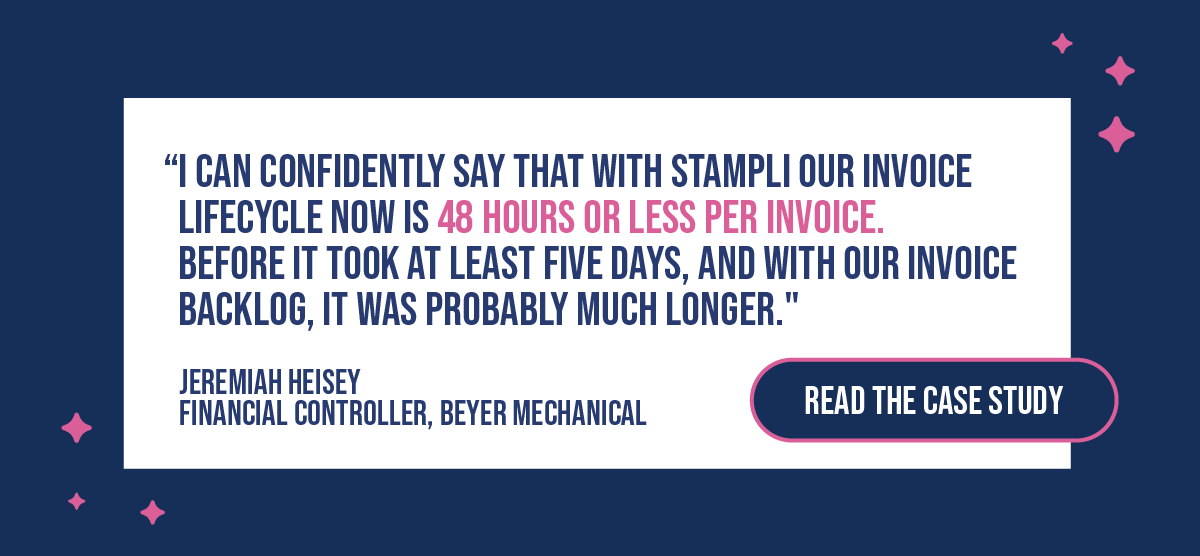
Like many construction companies, BTB Tech faces rising costs and market uncertainty, which has affected their ability to pay their suppliers.
According to the 2023 Rabbet Construction Payments Report, late payments for invoices and wages cost the US construction sector an estimated $273 billion per year. Late or delayed payments make up 13.9% of construction costs, and there was a 141% increase in liens filed by subcontractors in the 12 months prior to the report.
This disruption is having a major impact on the sector. In an earlier Rabbet report, 90% of general contractors said they see value in timely, reliable vendor payments, and 71% of subcontractors are considering potential customers’ payment reputations before bidding on projects.
In construction, you’re only as good as your reputation. BTB Tech enjoys excellent relationships with their subcontractors for one reason: because they always pay on time. This is also a significant competitive advantage for BTB — because they always pay on time, their projects are completed faster because their subcontractors and vendors prioritize BTB’s business.
Unfortunately, the disruptions affecting the construction industry have affected BTB Tech. While they haven’t gone over 60 days without paying a subcontractor, they’re definitely feeling the impact. Just last month, one of their biggest subcontractors met with BTB’s CEO to discuss their concerns with late payments.
After their meeting, BTB’s CEO directed their AP department to investigate their vendor payment processes and address the late payment issue. Abe started by digging into why the company is falling behind on payments.
What’s causing late payments?
Several factors cause late payments across every industry. Global economic and political instability affect supply chains and cause shortages, driving up the costs of things like building materials and tools. Rising inflation has also impacted prices and supply costs.
These factors have affected BTB Tech. For example, supply chain instability has made it more difficult for the company to source components. Shipping delays mean they don’t always know when those components will arrive. The delays also increase their risk – often, they face volatile international supplier pricing because of inflationary pressures and currency risk.
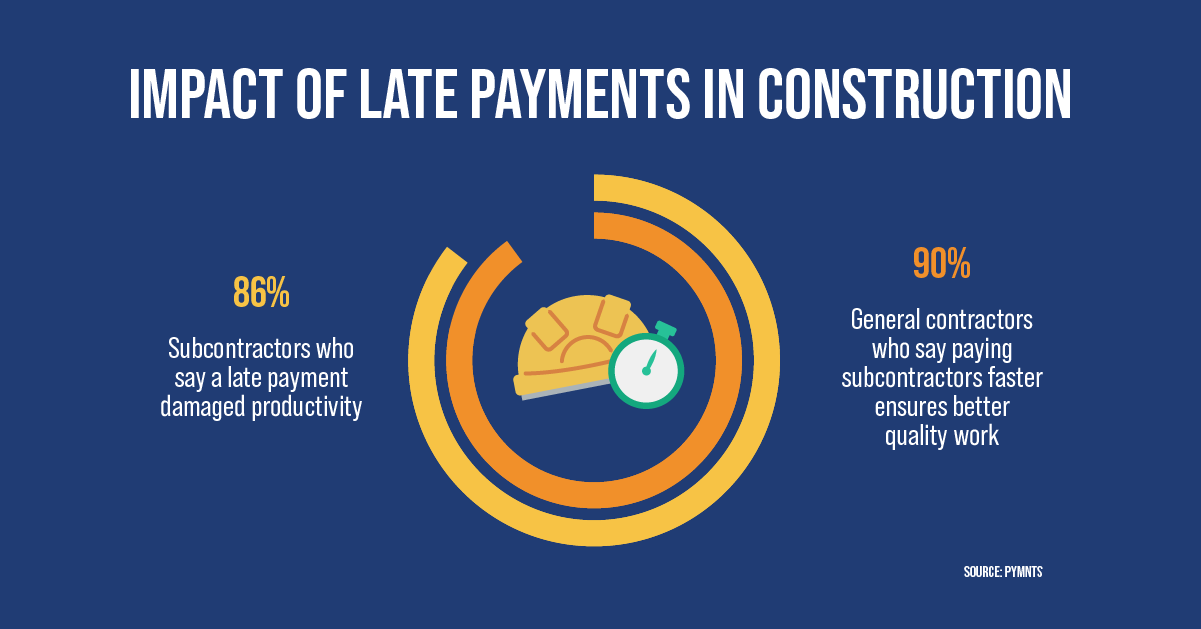
Closer to home, rising interest rates and declining demand continue to fuel fears of a recession in the US construction sector. Although BTB has been ok so far, fear of a recession has had a dampening effect on the construction market in general.
These external factors have affected their ability to pay suppliers, but Abe also looked at internal issues during his investigation. He discovered that the problem may lie in BTB’s reliance on manual invoice and payment processes and poorly integrated ERP and business systems.
BTB has traditionally relied on manual invoice processes and a construction accounting system to manage vendor payments. They rarely had any problems paying on time. However, as their business has grown, so has the volume of vendor invoices they receive. Their AP team (who now work at home 3 days a week) is getting overwhelmed with work. As a result, invoices are getting backlogged and BTB is falling behind on payments.
To maintain good vendor (and subcontractor) relationships, BTB needs to streamline their P2P workflows and better integrate their construction accounting system to ensure they process and pay invoices on time. They also need to more closely monitor their performance to ensure they don’t end up in the same place again.
Addressing this problem and improving vendor relations requires a multi-pronged approach.
Strategies for improving vendor payments
BTB thinks of their vendors as an extension of their business – their suppliers support their business and share in their success. To strengthen their vendor relationships and build greater flexibility and resilience in their business they are following 4 strategies to improve their vendor payment process.
Strategy 1: Assess vendor relationships and KPIs
BTB starts by inspecting the key performance indicators (KPI) for their procurement and payments process and assessing the health of their vendor relationships. Among the measures they’re looking at are:
Days Payable Outstanding (DPO): the average number of days BTB takes to pay their accounts payable balance. If DPO is too high, it shows they’re paying suppliers late. If it’s too low, it means they may not be taking advantage of credit terms to ensure healthy cash flow.
Number of payment errors: payment errors can damage vendor relationships. By monitoring the number of payment errors each month they can pinpoint and address the causes of the errors.
Percentage of supplier discounts captured: early payment discounts are a significant cost savings for their business. Tracking the percentage of discounts they take advantage of helps BTB ensure we’re maximizing their savings by paying before the due date.
Average time to process an invoice: tracking the average time it takes their AP team to process and approve invoices from purchase order to payment helps BTB set benchmarks for process improvements and shorten supplier payment times.
Accurate and timely KPI reporting and analytics lets businesses anticipate issues and manage their AP processes. Although they are powerful business tools, ERPs and construction management systems often fall short on AP reporting. Either they don’t provide the reporting capabilities AP departments need, or the process of accessing data and generating reports is demanding and complicated. Dedicated AP software solutions, like Stampli, come with a full suite of reporting tools, including analytics and real-time dashboards.
Improving vendor payments is a continuous process. After assessing their KPIs and improving their vendor payment processes, BTB plans to monitor their accounts payable KPIs like DPO to ensure they’re staying on track. Regular monitoring helps them identify and address inefficiencies and problems before they become serious. (All of which helps projects move faster as there aren’t payment delays to vendors or sub-contractors.)
Customers say Stampli’s reporting capabilities have “allowed for greater control and insight into company expenditures,” and by providing real-time insights into KPIs, have “been useful for our CFO and CEO to [measure] user productivity, which has allowed [their] AP clerk to analyze and find users causing backups in the approval process.”
Strategy 2: Commit to timely payments
According to a 2022 survey by the Association for Finance Professionals, 54% of businesses report speed of payment as their primary payment concern, followed by transaction cost (43%) and certainty of payment (42%).
This shouldn’t come as a surprise to anyone. BTB and their suppliers face the same economic uncertainty and challenges. If BTB is late paying a supplier, it can affect the supplier’s ability to operate their business and willingness to continue working with BTB. It’s more important than ever to pay suppliers on time.
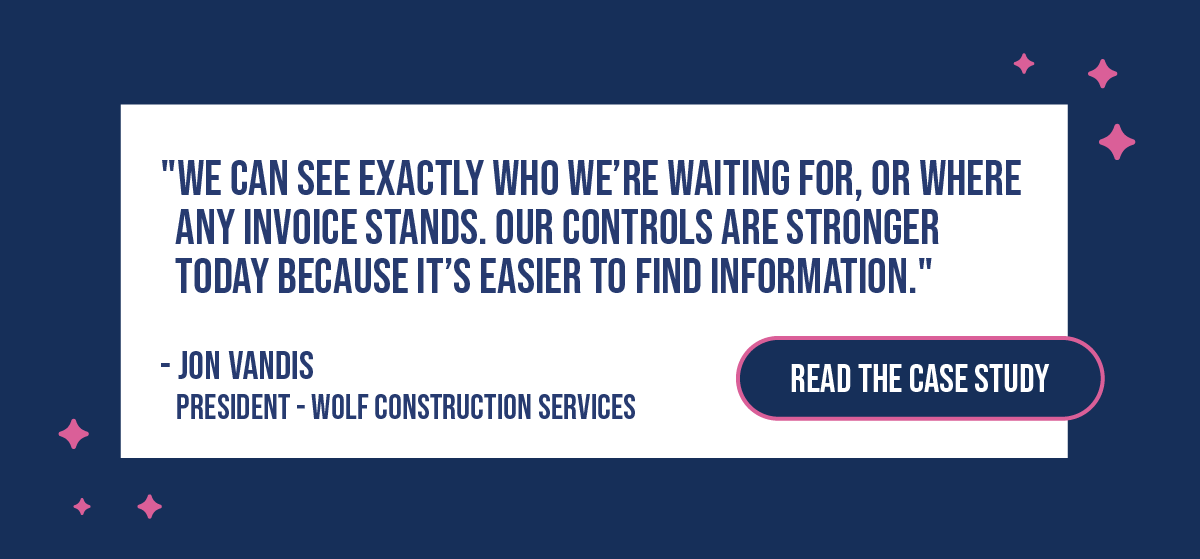
The solution to this problem is simple: commit to paying within a certain timeframe and ensure you pay on time. This is the best way to build supplier confidence and sets a realistic and attainable goal for BTB’s AP team to improve process efficiency.
While setting and committing to a payment goal is a great start, it’s only half the battle for paying vendors on time. Complex ERPs and business systems make already complex manual processes even worse. Most AP automation solutions simplify manual processes by replacing complex, time-consuming tasks, but best-of-breed solutions go beyond that — they integrate seamlessly with ERPs and business systems to reduce complexity.
Stampli’s pre-built integrations for ERPs and construction accounting systems lead the industry for their power, reliability, and flexibility. “I specialize in improving processes and at times that includes implementing software solutions;” says the treasurer for a construction company.”…with Stampli they were able to customize integration with our ERP system to allow us to track and better report fiber line buildout without any additional or duplicative work within the ERP system…adaptability is what I like most about this software.”
Strategy 3: Improve vendor communications
As their business grew, it became harder for their AP team members to stay in close contact with their vendors. This created a communication gap that became clear when they fell behind in invoice payments. Frustrated vendors would try to follow up with BTB on invoices, but their team was often late in replying.
BTB’s AP team was also frustrated with the challenges of getting payment terms and contact information from vendors and updating the information in their systems. The company missed a few vendor payments because they had the incorrect payment information and sent the payment to the wrong place.
It can be frustrating to keep vendor information updated, and that frustration can be magnified when AP teams feel like ERPs and business systems are working against them. Many ERPs and accounting systems are highly complex, with strict user roles and workflows. This complexity reflects the often-complicated tasks these systems need to do, but it can stand in the way of teams trying to do their work.
Advanced AP automation solutions like Stampli feature vendor portals to improve supplier communications and automate onboarding and updating vendor info. “Stampli is a top-tier A/P automation platform,” said the owner of one construction company on G2. “[It] features a great vendor management system for subcontractor documents that makes vendor management for construction companies a breeze.”
Strategy 4: Move to a vendor payment system
In their 2022 Sales Survey, Gartner reported that 83% of B2B buyers and sellers preferred ordering and paying through digital commerce. Again, this is no surprise–electronic payments are faster, cheaper, and more secure than paper checks and manual payment processes.
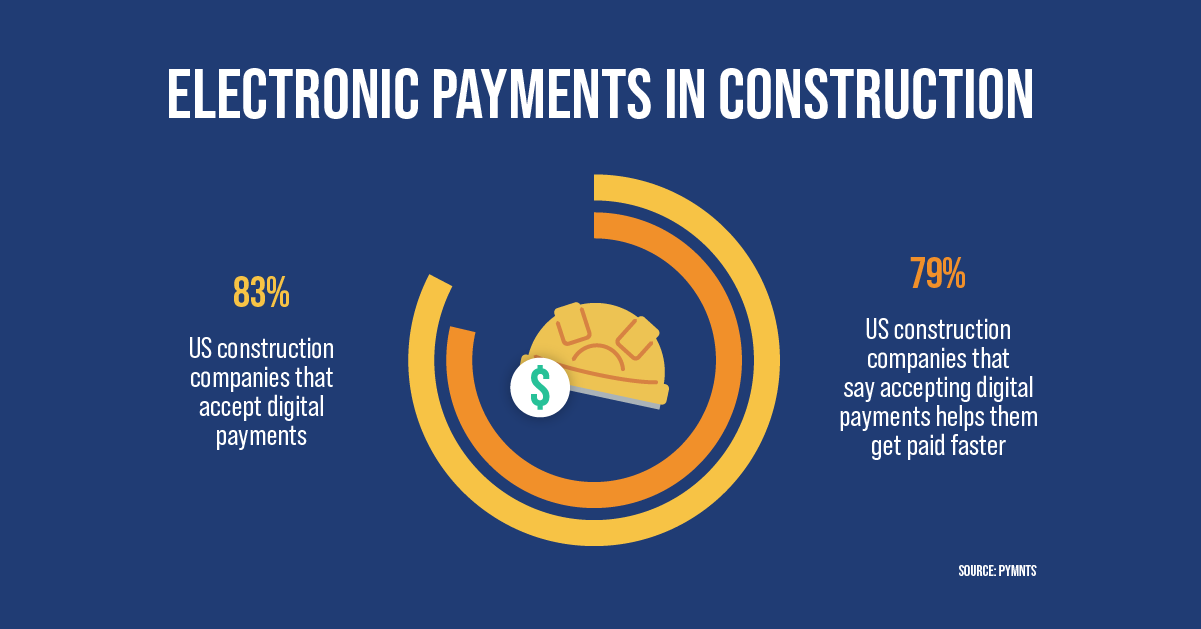
BTB’s reliance on manual processes and poorly integrated systems to pay vendors makes it difficult for them to transition to an electronic payment system. For their already overworked AP team, it’s just one more payment process to manage on top of all the others.
As part of their strategy to improve vendor payments, BTB plans to move to an automated accounts payable and payments management system. Systems like Stampli Direct Pay unify vendor payment methods onto a single platform. By reducing the time to process invoices and pay vendors, payment automation will help BTB meet their commitment to consistently paying vendors on time.
“We process over 1,000 invoices a month where each had to be manually added to our ERP system which would take our staff days. ” says one Stampli customer. ”Stampli has been able to reduce this entry time to a fraction of what it was – hours. This has freed up our staff’s time to work on other areas of our business. Having software which also issues payments on our behalf saves time not having to manually print, sign and stuff checks. By and large if there was one essential area of Stampli benefitting our business is TIME.”
Choose the right vendor payment automation solution
By implementing these 4 strategies, BTB can get control of their vendor payment process and pay their vendors on time. The key is choosing the right accounts payable automation solution to optimize their entire purchase-to-pay cycle.
BTB is choosing Stampli as their AP automation partner. Stampli lets them monitor their KPIs in real time, improve their invoice processing time, manage vendor information, and switch to a unified vendor payment solution.
Improve vendor payment performance with Stampli
Stampli’s industry-leading AP solution uses machine learning and AI to automate invoice management, streamline vendor payment processes, and bring efficiency by automating previously manual processes. AP automation lets companies move invoices through the AP process more efficiently.
“We finally have a single repository for all invoices and can search for an invoice quickly,” says a happy Stampli customer. “It has formalized our Approval workflow. It has reduced Approval turnaround. We are a Construction Company and must submit Bank draws to fund our payments. That entire process was shortened by three days in our first month just because our [a]pprovers found it simple to use and [r]eviewing invoices was no longer something they dreaded.”
Stampli helps control human error and fraud by presenting real-time data and KPIs via visual dashboards. As a result, businesses can continuously monitor and improve their invoice processing efficiency.
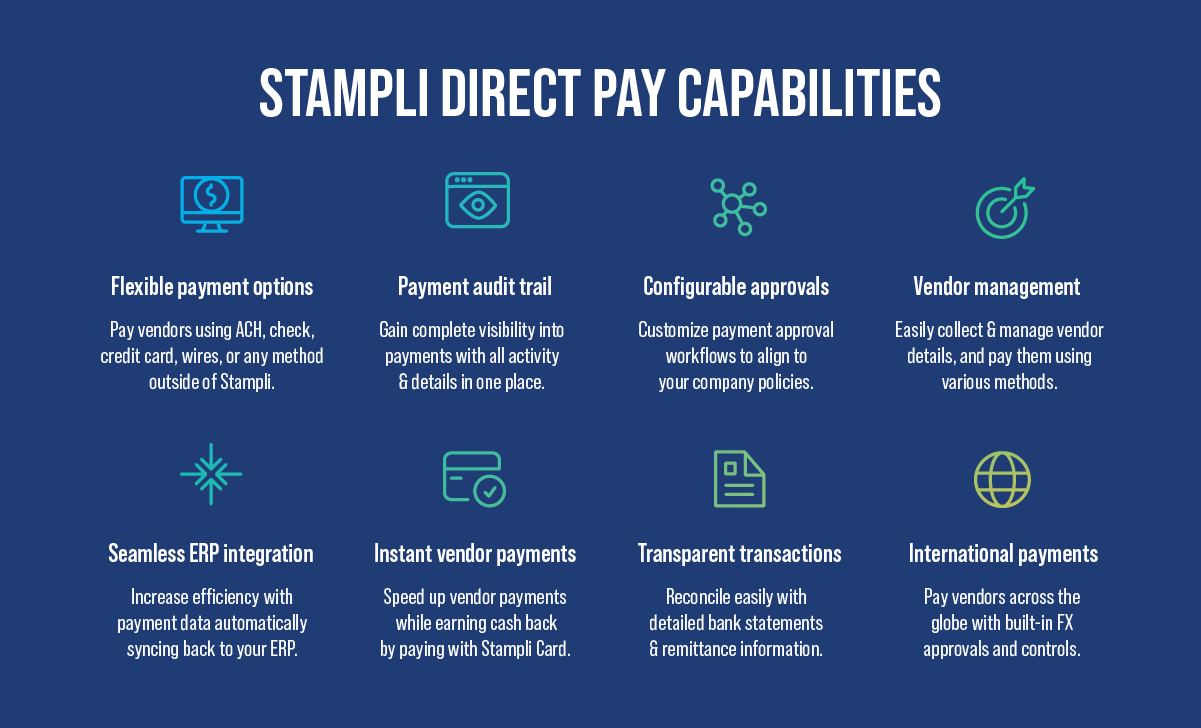
For maximum payment efficiency, empower Stampli’s AP automation solution with three other solutions:
- Stampli Direct Pay to automate vendor payment management
- Stampli Card to manage corporate cards and AP automation from one solution
- Advanced Vendor Management to automate vendor onboarding and communications
With Direct Pay and Stampli Card, companies can control their vendor relationships, centralize their payment methods, and speed up their vendor payments.
Here’s what customers have to say about paying vendors with Stampli:
Exceptional customer service
Many AP automation solutions promise flexibility and powerful features but fall short on customer service. As the industry leader in AP automation, Stampli excels at all three.
“Stampli actively seeks out feedback from users and implements new features and seems a bit more of a risk taker in developing its product which is a little bit more my speed,” says one reviewer. “[H]aving worked with Stampli before I had a peace of mind of knowing what I was getting and that I could lead the charge on implementation and troubleshooting.”
Next-generation AP automation
Some AP solutions promise but don’t deliver, often falling short on functionality, ease of use, and flexibility. Stampli is designed for AP teams and the way AP teams work. It provides a simple, intuitive interface where everything AP needs to know is centralized on top of the invoice.
Stampli “is competitive in quality to other AP software whose companies have been around significantly longer like Bill.com and Tipalti,which is impressive and speaks to their continuous product improvements and innovations,” says one treasurer. “As a Stampli user at 2 different companies for over 3 years, I’m impressed at how the product keeps improving with new feature roll outs and careful collection of customer feedback.”
Seamless pre-built integrations
The proof in the pudding for any AP automation solution is how well it integrates with ERPs and accounting software. Integration is where many solutions fall short because of long implementation times, glitchy interfaces, or lost business data.
You can implement Stampli’s pre-built ERP integrations without coding or rework to your ERP, and they fully support your ERP’s native functionality. In the words of one business owner: “Stampli integrates seamlessly with our construction management software making it easy to send and receive documents that need multiple approvals…Once a document is signed in Stampli our construction managament software is automatically notified that all parties have signed and the status is changed to approved. I am alos able to issue the signed documents to outside consultants if required.”
The bottom line: Stampli is the ideal choice for streamlining your vendor payment process. Contact Stampli today for a free demo.
